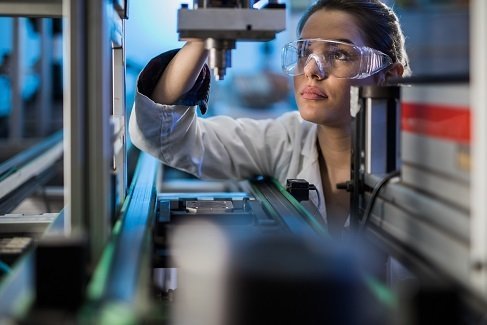Today, there are a lot of actress/singer/models, but what where are they actress/scientists? Natalie Portman is one of a handful of high-profile actors who happen to have serious scientific credentials — awards, degrees, patents and theorems in their name. The list also includes Danica McKellar, best known for her role in “The Wonder Years,” who graduated summa cum laude in math from UCLA where she helped devise a mathematical proof for certain properties of magnetic fields and Mayim Bialik, formerly “Blossom” and currently a star on “The Big Bang Theory,” has a PhD in Neuroscience. Actress/rocket scientist Heddy Lamarr paved the way as the first, accomplished actress/scientist.
Most people who recognize the name “Hedy Lamarr” know that she was an actress and icon of Hollywood glamour during the Interwar period. It’s a fair association – the Austrian-born Lamarr (born Hedwig Kiesler in Vienna in 1914) – is most famous for her role in provocative and groundbreaking films of the 1930s and 1940s. Lamarr, however, was also a talented inventor.
Married at the beginning of her career to one of the richest men in Austria, Lamarr learned about applied science and the business of military technology when she sat in on her husband’s business meetings. Seeking to escape his stifling control and associations with the fascist governments of Germany and Italy, Lamarr left her husband in 1937 and set out for Paris. There she met Louis B. Mayer, the Hollywood producer who began her American career.
With a new name and a powerful friend in the studio system, Lamarr began her career in California. As her film career took off, Lamarr maintained her interest in the sciences. During World War II, with George Antheil, a composer who shared her fascination with radio waves and military technology, Lamarr made a groundbreaking discovery. She and Antheil realized that the torpedo technology of the day was almost entirely based on radio waves, and that by disrupting the radio waves setting the torpedos’ courses, they could prevent them from meeting their targets. To prevent enemy forces from jamming the disrupting frequencies, they developed technology that skipped from frequency to frequency, disrupting communications with the torpedo without giving the enemy the time to engage in countermeasures.
They fine-tuned their invention and applied for a patent (she under her married name), which was granted. Upon presenting their groundbreaking idea to the US Navy, however, Lamarr and Antheil were rejected. The Navy had misgivings, and so the idea was shelved. Undeterred and determined to contribute to the war effort, Lamarr applied to the National Inventor’s Council. The government turned her down, suggesting that she would be more useful if she applied her fame to selling War Bonds.
In hindsight, the NIC may have missed a valuable opportunity to use Lamarr’s fame to increase women’s participation in different areas of the war effort. The twenty-first century mind leaps easily to the idea of a sort of Rosie the Riveter of invention and technology, a figure of female empowerment and engagement. Hindsight, though, is clearer, and while we can criticize the decisions made in the past we have no way of changing them. Eventually, even though she was consigned to selling War Bonds rather than being welcomed as a colleague by fellow inventors, Lamarr’s invention had the impact she hoped.
After World War Two, Lamarr’s career declined. She appeared in few films after 1950, and her ghostwritten 1966 autobiography was met with critical reviews. Her work, however, lived on. The technology she developed was first used in a military context in the 1960s, and continues to form the basis of many military communications systems.
In the civilian world, Lamarr’s legacy lives on. Like many iconic Hollywood figures, she was awarded a star on the Hollywood Walk of Fame. Her contributions in the world of science, however, may play a larger role in most of our lives. Her work laid the groundwork for the Bluetooth, WiFi, and GPS technologies that play an ever-increasing role in modern life.






A problem. You say ” (Hedy) Lamarr (born Hedwig Kiesler in Vienna in 1938) – is most famous for her role in provocative and groundbreaking films of the 1930s and 1940s. ” She was doing very sexy movies before being born?
Thanks for catching that Jerry – we updated her birthyear!